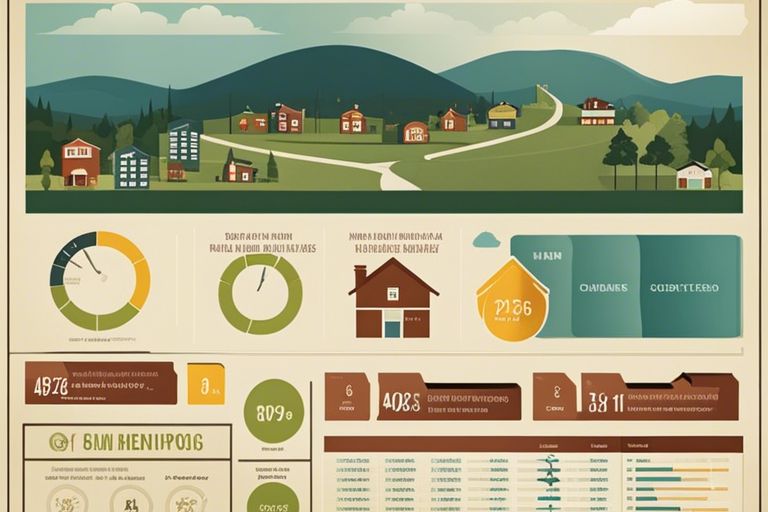With the vast amount of property data available today, exploring county parcels can unveil a treasure trove of valuable insights that can benefit homeowners, investors, and real estate professionals alike. From understanding property values and market trends to identifying potential investment opportunities and development prospects, the analysis of property data can provide a deeper understanding of the real estate landscape within a county.
Uncovering Hidden Patterns
Identifying Trends in Property Values
An analysis of property data can reveal valuable insights about trends in property values within county parcels. This information can help investors, real estate professionals, and government agencies make informed decisions regarding property investments, developments, and taxation.
Revealing Insights into Land Use and Zoning
Property data can also provide insights into the land use and zoning regulations within county parcels. By examining this data, stakeholders can understand the current and potential future uses of land, which can influence decisions related to urban planning, infrastructure development, and environmental conservation.
Trends in land use patterns can indicate areas of growth, potential for commercial or residential development, and the impact of zoning policies on property values. By analyzing these patterns, stakeholders can anticipate changes in the real estate market and adjust their strategies accordingly.
Demographic Analysis
Unraveling the Mystery of Population Growth
Little can reveal as much about a county as its population growth. By analyzing property data, one can uncover valuable insights into the trends and drivers behind a county’s changing population dynamics. Understanding population growth is crucial for developers, investors, and policymakers to make informed decisions regarding property development and services.
Insights into Age, Income, and Education Demographics
To gain a comprehensive picture of a county, examining demographic factors such as age, income levels, and education is necessary. Property data can offer insights into the distribution of these demographics within a specific area, shedding light on consumer behavior, housing preferences, and economic opportunities.
An in-depth analysis of age demographics can provide clues about the demand for housing types, such as starter homes for young families or retirement communities for aging populations. Income demographics can help pinpoint areas with potential for real estate investment, while education data can indicate the presence of a skilled workforce and the need for educational facilities.
Environmental Factors
Any property data analysis would be incomplete without considering the impact of environmental factors on county parcels. These factors can range from climate and natural disasters to the role of environmental conservation in shaping the value and desirability of properties. After all, the surroundings of a property can greatly influence its market value and attractiveness to potential buyers or investors.
How Climate and Natural Disasters Impact Property Values
To understand the full picture of a property’s value, one must take into account how climate patterns and the risk of natural disasters can affect it. Properties in areas prone to hurricanes, wildfires, or flooding may experience fluctuations in value based on the perceived risk of these events. Prospective buyers may be willing to pay more for properties with lower risk, leading to a direct impact on property values.
The Role of Environmental Conservation in Shaping County Parcels
Property data can also shed light on how environmental conservation efforts influence the development and use of county parcels. Conservation areas, parks, and green spaces can enhance the quality of life in a community, making properties nearby more desirable. These areas may also be subject to regulations that restrict development, which can impact property values and land use plans in the long run.
With a better understanding of how environmental factors interact with property data, stakeholders can make more informed decisions about county parcels, taking into account both the present value and future potential of properties in a changing environment.
Economic Implications
The Impact of Property Data on Local Economies
Once again, property data proves to be a crucial tool in understanding the economic landscape of a county. By analyzing property values, ownership trends, and market fluctuations, stakeholders can gain valuable insights into the financial health of a region. This information can help inform policy decisions, attract potential investors, and stimulate economic growth.
How County Parcels Influence Business Development and Investment
Property data can directly impact business development and investment decisions within a county. By examining parcel information, entrepreneurs and investors can identify areas with high growth potential, assess market demand, and make informed choices regarding property acquisitions. This data also enables businesses to tailor their strategies to local market conditions, fostering sustainable development and economic prosperity.
Understanding the relationship between county parcels and business development is necessary for fostering a thriving economic ecosystem. By leveraging property data to analyze zoning regulations, land use patterns, and demographic trends, stakeholders can identify strategic locations for new businesses, commercial developments, and infrastructure projects. This insight not only attracts investors but also promotes sustainable growth, job creation, and community prosperity.
To wrap up
With this in mind, it is evident that property data holds a wealth of invaluable insights about county parcels. From understanding property values and trends to identifying potential investment opportunities and development patterns, analyzing property data can provide valuable information for homeowners, investors, and policymakers alike. By delving into the intricacies of property data, we can gain a deeper understanding of our communities and make more informed decisions regarding real estate.

